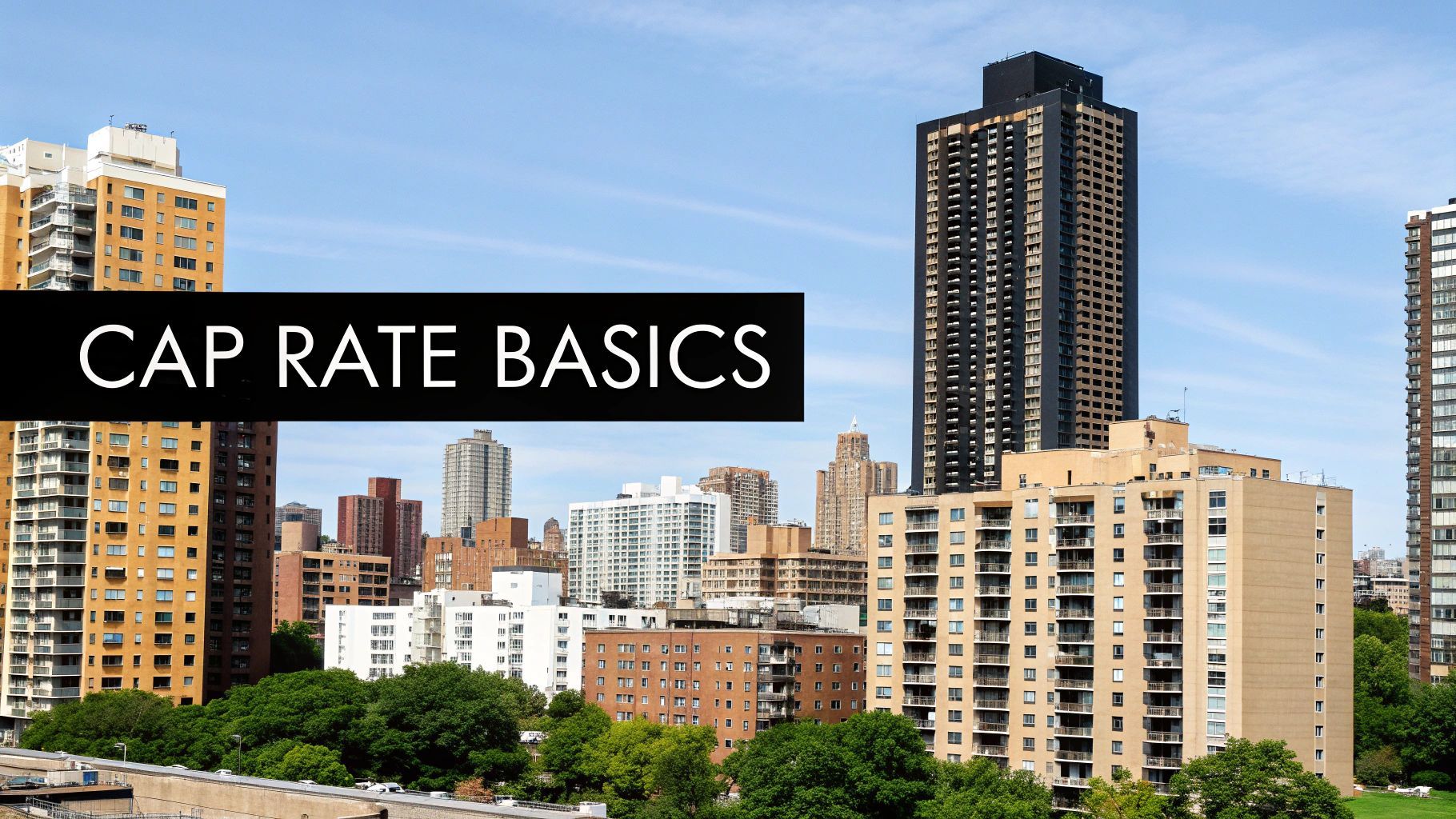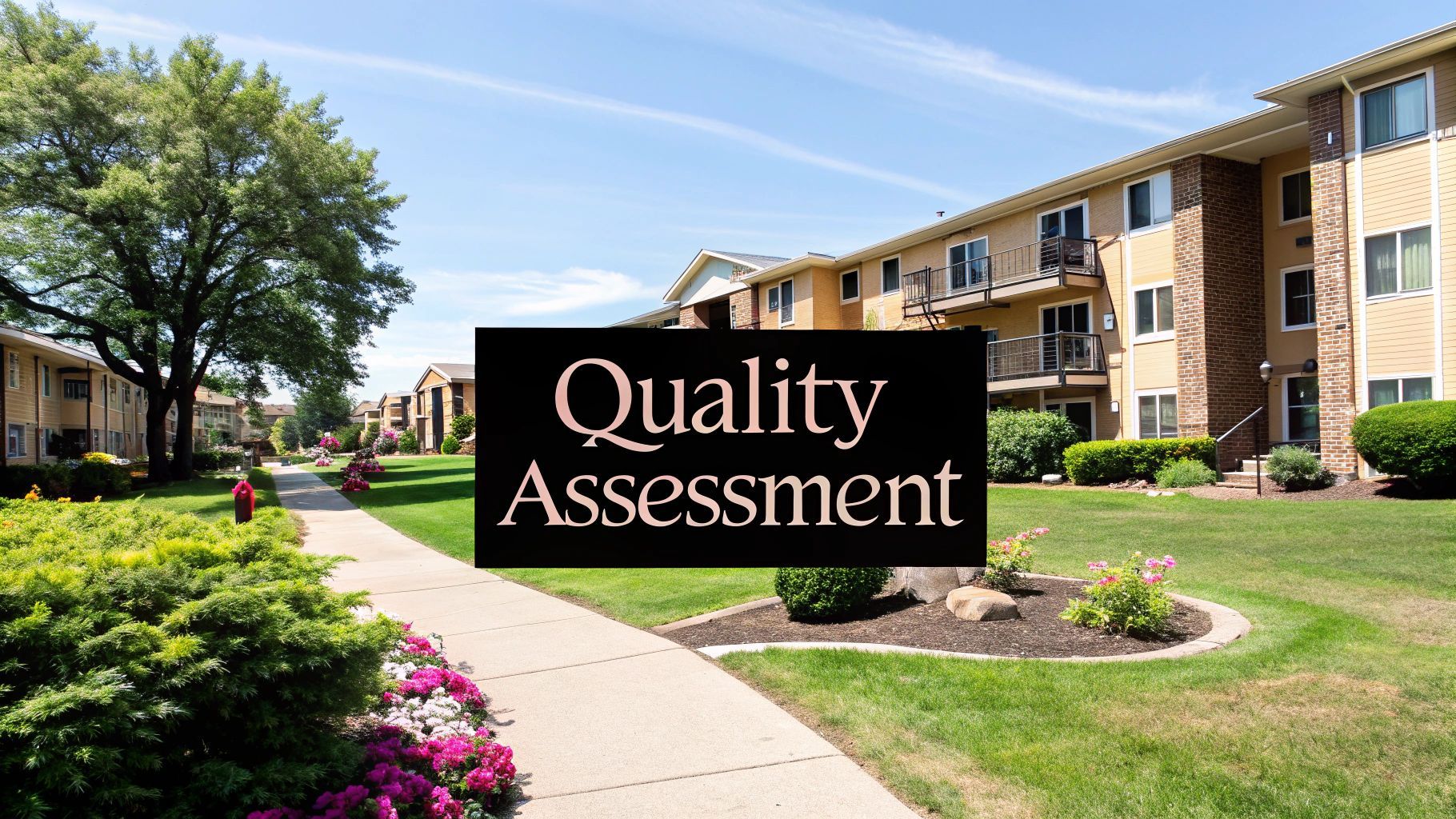The Ultimate Guide to Apartment Building Cap Rates: Expert Analysis for Investors
The Ultimate Guide to Apartment Building Cap Rates: Expert Analysis for Investors
Master the essentials of apartment building cap rates with expert insights on calculation methods, market trends, and investment strategies. Learn how cap rates influence multifamily property values and investment decisions.
Domingo Valadez
Dec 29, 2024
Blog
Understanding Cap Rates: Beyond the Basic Numbers

The calculation of an apartment building cap rate seems simple enough - Net Operating Income divided by Market Value. However, experienced investors know this number alone doesn't tell the full story. A cap rate provides just a snapshot of potential returns at one point in time. Smart investors use it as one of several key metrics when evaluating multifamily properties.
Deciphering the Cap Rate Puzzle
At first glance, a high cap rate may look appealing since it suggests strong returns. But this could actually signal elevated risk factors related to the property or location. On the flip side, a lower cap rate might appear less profitable initially but often indicates a stable investment in a prime area with lower risk. This is why seasoned investors examine cap rates alongside other critical elements like local market trends, property condition, and growth potential.
Market Influences and the Cap Rate Dance
Local economic conditions directly impact apartment building cap rates. Areas with strong population growth and low vacancy tend to have lower cap rates due to high investor demand. Interest rates also play a major role - when rates increase, as we've seen recently, higher borrowing costs affect what buyers can pay, pushing cap rates up. For example, national multifamily cap rates rose 83 basis points from 2022 to 2023, followed by another 29 point increase in 2024, showing how market forces shape these metrics.
Property Characteristics and the Cap Rate Spectrum
Each property's unique features help determine its cap rate. Factors like age, condition, and amenities all affect perceived value and risk. For instance, a newly updated building with high-end amenities in a prime spot typically commands a lower cap rate than an aging property needing repairs, even in the same area. This explains why investment properties often see cap rates ranging from 4% to 10%, reflecting the diversity of building types and locations. Understanding these differences helps investors choose properties matching their goals and risk tolerance.
Beyond the Numbers: A Holistic Approach
Success in multifamily investing requires looking past simple cap rate calculations. By examining market trends, property specifics, and future growth prospects together, investors gain deeper insight into a property's true potential. This complete view enables smarter decisions that balance risk and returns over time. With this foundation, we can now explore how regional market dynamics affect investment opportunities, which we'll cover next.
Navigating Regional Market Dynamics and Trends

Looking at individual property metrics only tells part of the story when evaluating apartment building cap rates. A broader view of regional market dynamics helps investors spot promising opportunities and avoid potential pitfalls. Consider how a seemingly attractive cap rate in a declining market might hide serious risks that national averages wouldn't catch. Making investment decisions based purely on numbers, without understanding the local context, can lead to costly mistakes.
Key Regional Factors Affecting Apartment Building Cap Rates
Several important local factors shape how cap rates vary across different regions. Understanding these market-specific elements is essential for making sound investment choices:
- Population Growth and Migration: Fast-growing areas typically see higher housing demand, pushing property values up and cap rates down. In contrast, areas losing residents often have higher cap rates due to reduced buyer interest.
- Employment Trends: Strong job markets and healthy income levels tend to boost rental demand, leading to lower cap rates. For instance, cities with major universities or thriving business sectors often have lower cap rates thanks to steady demand from students and professionals.
- Local Regulations and Zoning: Building codes, rent control laws, and other rules directly affect both costs and income potential, influencing cap rates. This makes understanding local regulations a key part of any market analysis.
- Supply and Demand Dynamics: The balance between available units and renter demand shapes cap rates significantly. Too many apartments can mean higher vacancies and lower rents, potentially raising cap rates. Areas where demand outpaces supply often see lower cap rates.
Analyzing Regional Cap Rate Trends
Smart investors use several proven methods to analyze regional trends and find good opportunities:
- Comparative Market Analysis: Looking at cap rates across similar markets helps spot areas that might be undervalued or overpriced. Two similar cities might have different cap rates because of local supply levels or regulations - differences that could signal investment opportunities.
- Trend Identification: Watching how cap rates change over time reveals market patterns and emerging opportunities. While national data gives a broad picture, regional trends offer deeper insights into local conditions, helping investors spot value shifts early.
- Consideration of Future Development: Understanding planned construction, infrastructure projects, and other upcoming changes helps predict how markets might change. This forward-looking view helps investors find areas poised for growth and potentially better returns. New transit lines or major employers moving in can significantly affect an area's appeal and cap rates.
A thorough understanding of regional market conditions helps investors find properties with cap rates that match their goals and risk comfort level. This local focus, combined with careful property analysis, forms the foundation for successful multifamily investing. These market insights lead naturally into our next topic: how interest rates affect property values.
The Interest Rate Effect: Impact on Property Values

Interest rates shape property values in profound ways, creating ripple effects throughout real estate markets. The connection between interest rates and apartment building cap rates is especially important for investors to grasp. When interest rates increase, buyers face higher borrowing costs, which limits what they can afford to pay for properties. This reduced purchasing power often pushes cap rates higher as property values adjust downward.
How Rising Interest Rates Impact Apartment Building Cap Rates
The relationship between interest rates and cap rates becomes clear when examining the basic cap rate formula: Net Operating Income (NOI) divided by Market Value. Consider a property generating $70,000 in annual NOI. If rising interest rates cause its market value to drop from $1 million to $800,000, the cap rate jumps from 7% to 8.75%, even though the NOI stays the same. This shows how higher rates can drive cap rates up by pushing property values down.
Real-World Examples of Interest Rate Influence
Recent market data tells the story clearly. From 2022 to 2023, national multifamily cap rates rose by 83 basis points, followed by another 29 basis point increase in 2024. These rises came in direct response to the Federal Reserve's interest rate hikes aimed at controlling inflation. As borrowing became more expensive, buyers could afford to pay less for properties, causing values to drop and cap rates to climb. This dynamic makes it essential for investors to factor in the interest rate environment when evaluating deals.
Strategies for Navigating Changing Interest Rate Environments
Success in shifting rate environments requires adaptability and careful planning. Smart investors often rely on several key approaches:
- Stress Testing Investments: Running scenarios with different interest rate assumptions helps investors understand how changes could affect returns. This means analyzing potential impacts on both financing costs and property values.
- Focusing on Value-Add Opportunities: Properties with room to boost NOI through improvements or better management can help offset the effects of rising rates. By growing income, investors may counter some of the negative pressure that higher rates put on values.
- Monitoring Market Trends: Staying current on rate forecasts and investor sentiment enables timely strategy adjustments. Regular market analysis helps investors spot shifts early and adapt their approach.
Looking at historical patterns also provides useful context. Multifamily cap rates typically maintain a positive spread above 10-year Treasury yields, suggesting higher potential returns compared to risk-free investments. However, this spread fluctuates with market conditions, highlighting why ongoing analysis matters. Armed with these strategies, investors can better handle rate changes while optimizing returns. This foundation in interest rate effects leads naturally into our next topic: understanding cap rate spreads and risk premiums.
Understanding Cap Rate Spreads and Risk Premiums

To truly understand apartment building investments, you need to look beyond basic cap rates and examine risk versus return. Smart investors analyze cap rates in relation to other investment options, particularly U.S. Treasury yields, which are considered "risk-free." This comparison helps determine how much additional return investors get for taking on the risks of real estate compared to safer government bonds.
Evaluating Cap Rate Spreads Against Treasury Yields
The difference between an apartment building's cap rate and the 10-year Treasury yield shows how risky investors consider the property. For instance, if an apartment has a 7% cap rate and the Treasury yields 4%, the 3% spread represents what investors expect for handling property-specific risks like vacancies and maintenance needs. Over time, multifamily properties have averaged spreads around 215 basis points above Treasury yields, though this varies with market conditions.
Assessing Risk Premiums Across Different Property Classes and Locations
Not all real estate investments carry the same level of risk. A high-end apartment building in a prime downtown area typically has a lower cap rate and smaller spread over Treasury yields compared to an older building in a secondary market. This makes sense - the prime location and quality mean less risk. Meanwhile, older properties might offer higher cap rates but face greater challenges with vacancies, repairs, and economic shifts. Looking at these differences helps investors accurately gauge risk versus reward.
Identifying Mispriced Assets and Optimizing Portfolio Returns
By studying cap rate spreads across properties, investors can spot potential deals where the risk-return profile seems out of balance. Some buildings might have unusually high cap rates given their actual risk level. For example, an apartment complex in an up-and-coming neighborhood could offer returns that don't reflect its improving location and prospects. Finding these opportunities requires understanding both property fundamentals and market dynamics. This knowledge of cap rate spreads provides a foundation for deeper analysis of key market factors.
Market Fundamentals: Supply, Demand, and Valuation
Understanding apartment building cap rates requires looking at the basic forces of supply and demand in local markets. These market dynamics provide essential context for interpreting cap rates and making smart investment decisions. A seemingly attractive cap rate could be less appealing in an oversupplied market, while a lower cap rate might signal a great opportunity in a high-demand area with limited housing options.
The Supply Side: New Construction and Its Impact on Cap Rates
New apartment construction plays a key role in shaping market conditions and cap rates. When many new units enter a market, it can drive down rents and increase vacancies if demand doesn't match the growing supply. This puts pressure on property income and can push cap rates higher as investors seek better returns to offset increased risk. For this reason, closely tracking construction pipelines and future supply projections is essential when evaluating potential investments. Having too many similar properties in one area can also create direct competition that affects both rental rates and property values.
The Demand Side: Population Growth, Employment, and Local Amenities
Several key factors drive rental housing demand, including population growth, job market health, and desirable neighborhood features. Areas with strong population increases and robust employment typically see higher housing demand, which can boost rents and lower cap rates as properties become more valuable. For example, when cities attract new businesses or see major employer expansions, housing demand often rises sharply, leading to lower vacancy rates and stronger rent growth. Properties near good schools, parks, and public transit can also command premium rents, which impacts cap rates. Learn more in our article about How to master multifamily property investing.
Valuation in the Context of Supply and Demand
The relationship between supply and demand directly affects property values and cap rates. When demand significantly exceeds available housing supply, property values tend to increase, resulting in lower cap rates. On the flip side, oversupplied markets often see declining values and higher cap rates. This highlights why investors must look beyond just cap rates to understand the full market picture. A thorough analysis considers both current conditions and future trends. For instance, identifying areas set for major job growth or infrastructure improvements can reveal future demand increases and appreciation potential.
Practical Application: Analyzing Market Fundamentals
To effectively use market fundamentals in investment decisions, investors should:
- Comparative Market Analysis: Study how supply and demand patterns in the target market compare to similar areas to spot potential opportunities
- Local Economic Data: Review employment reports, population projections, and economic indicators to gauge demand strength and sustainability
- Supply Pipeline Analysis: Keep track of planned and ongoing construction to understand how new supply might affect the market
By combining these approaches with a solid grasp of cap rates, investors can develop a complete view of a property's potential and make well-informed decisions. This understanding naturally leads to evaluating specific property characteristics that influence individual valuations.
Building Your Investment Strategy: Putting It All Together
Whether you're just starting out or looking to expand your real estate portfolio, getting cap rates right is essential but only one part of the equation. Smart investors take a broad view by looking at cap rates alongside other key data points to make informed choices. This allows them to assess risk, identify strong opportunities, and build resilient portfolios for the long term.
Integrating Cap Rate Analysis with Other Key Metrics
While cap rates provide a helpful initial screening tool, relying on them alone can lead to poor decisions. A high cap rate property could face serious deferred maintenance or be located in a declining area. Meanwhile, a lower cap rate asset in a top market might offer excellent long-term appreciation potential. That's why it's important to evaluate several factors together:
- Cash Flow Analysis: Run detailed projections factoring in realistic rent growth, expenses, and vacancy assumptions to understand true income potential over your planned hold period.
- Market Research: Study local economic indicators, demographic trends, and supply/demand dynamics to put cap rates in proper context. Strong market fundamentals can justify paying a lower cap rate.
- Property Condition Assessment: Carefully inspect buildings and systems to identify needed repairs and improvements. Factor these capital costs into your analysis since they will impact future NOI and valuation.
Adapting Your Strategy to Changing Market Dynamics
Real estate markets never stand still - they shift constantly with interest rates, economic cycles, and local factors. Successful investors stay flexible and adjust their approach. For example, in today's higher rate environment with rising cap rates, many buyers are focusing on value-add deals where they can boost NOI through active management to maintain returns.
Supply and demand also drive cap rate trends in meaningful ways. In growth markets with limited new construction, strong competition often compresses cap rates. But in areas with heavy development pipelines, cap rates may rise as buyers gain negotiating leverage. Understanding these dynamics helps investors spot emerging opportunities.
Frameworks for Risk Assessment, Property Evaluation, and Portfolio Optimization
Building a resilient strategy requires systematic methods for evaluating opportunities and managing risk:
- Stress Testing: Model various scenarios including rising rates, falling rents, or higher expenses to understand how properties might perform in different conditions.
- Diversification: Spread investments across property types, locations, and risk profiles. Balance core assets providing stable income with value-add deals offering higher potential returns.
- Due Diligence: Follow a thorough checklist covering physical inspections, financial review, market analysis, and legal/regulatory compliance before any acquisition.
By taking this comprehensive approach - analyzing cap rates alongside other metrics, adapting to market shifts, and using structured evaluation frameworks - investors position themselves for sustainable long-term success.
Ready to streamline your real estate syndication process and manage your investments more effectively? Homebase offers an all-in-one platform designed to simplify fundraising, investor relations, and deal management. Visit https://www.homebasecre.com/ to learn more and transform your investment approach.
Share On Linkedin
Share On Twitter
Share On Linkedin
Share On Twitter
DOMINGO VALADEZ is the co-founder at Homebase and a former product strategy manager at Google.
What To Read Next
How Do You Calculate Cap Rate A Real Estate Investor's Guide
Blog
Learn how do you calculate cap rate with our guide. We cover the formula, NOI, and real-world scenarios to help you make smarter property investment decisions.
Sign up for the newsletter
If you want relevant updates from our team at Homebase, sign up! Your email is never shared.
Sign up for the newsletter
If you want relevant updates from our team at Homebase, sign up! Your email is never shared.
© 2025 Homebase. All rights reserved.